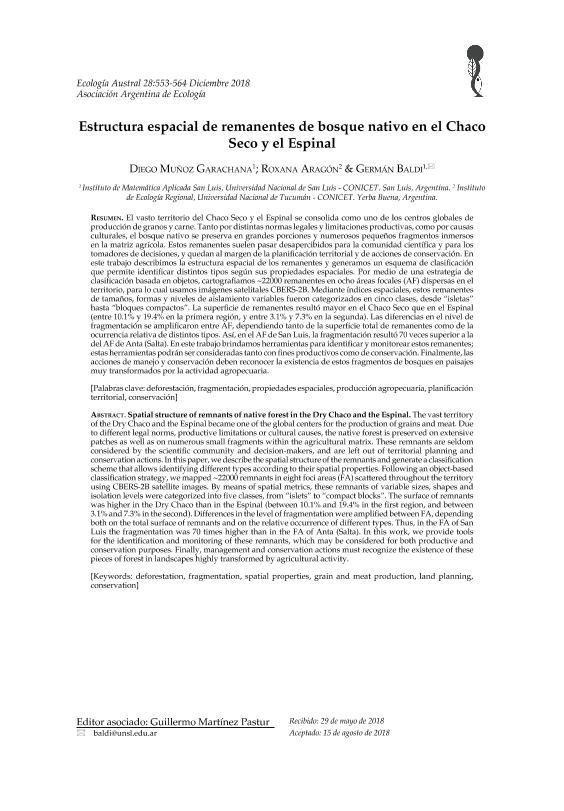Mostrar el registro sencillo del ítem
dc.contributor.author
Muñoz Garachana, Diego
dc.contributor.author
Aragón, Myriam Roxana

dc.contributor.author
Baldi, Germán

dc.date.available
2020-03-13T20:35:17Z
dc.date.issued
2018-10
dc.identifier.citation
Muñoz Garachana, Diego; Aragón, Myriam Roxana; Baldi, Germán; Estructura espacial de remanentes de bosque nativo en el Chaco Seco y el Espinal; Asociación Argentina de Ecología; Ecología Austral; 28; 3; 10-2018; 553-564
dc.identifier.issn
0327-5477
dc.identifier.uri
http://hdl.handle.net/11336/99601
dc.description.abstract
El vasto territorio del Chaco Seco y el Espinal se consolida como uno de los centros globales de producción de granos y carne. Tanto por distintas normas legales, limitaciones productivas, o causas culturales, el bosque nativo se preserva en grandes porciones y numerosos pequeños fragmentos inmersos en la matriz agrícola (en lo subsiguiente, "remanentes"). Estos remanentes suelen pasar desapercibidos para la comunidad científica y los tomadores de decisiones, quedando al margen de la planificación territorial y de acciones de conservación. En este trabajo describimos la estructura espacial de los remanentes, y generamos un esquema de clasificación que permite identificar distintos tipos según sus propiedades espaciales. Siguiendo una estrategia de clasificación basada en objetos, cartografiamos ~22,000 remanentes en ocho áreas focales (AF) dispersas en el territorio usando imágenes satelitales CBERS-2B. Mediante índices espaciales, estos remanentes de tamaños, formas, y niveles de aislamiento variables, fueron categorizados en cinco clases, desde "isletas" hasta "bloques compactos". La superficie de remanentes resultó mayor en el Chaco Seco que en el Espinal (entre 10.1% y 19.4% en la primera región, y entre 3.1% y 7.3% en la segunda). Las diferencias en el nivel de fragmentación se amplificaron entre AF, dependiendo tanto de la superficie total de remanentes, como de la ocurrencia relativa de distintos tipos. Así, en AF San Luis la fragmentación resultó 70 superior que en AF de Anta (Salta). En este trabajo brindamos herramientas para la identificación y el monitoreo de estos remanentes, las cuales podrán ser consideradas tanto con fines productivos como de conservación. Finalmente, las acciones de manejo y conservación deben reconocer la existencia de estos fragmentos de bosques en paisajes altamente transformados por la actividad agropecuaria.
dc.description.abstract
The vast territory of the Dry Chaco and the Espinal became one of the global centers for the production of grains and meat. Due to different legal norms, productive limitations or cultural causes, the native forest is preserved on extensive patches as well as on numerous small fragments within the agricultural matrix. These remnants are seldom considered by the scientific community and decision-makers, and are left out of territorial planning and conservation actions. In this paper, we describe the spatial structure of the remnants and generate a classification scheme that allows identifying different types according to their spatial properties. Following an object-based classification strategy, we mapped ~22000 remnants in eight foci areas (FA) scattered throughout the territory using CBERS-2B satellite images. By means of spatial metrics, these remnants of variable sizes, shapes and isolation levels were categorized into five classes, from “islets” to “compact blocks”. The surface of remnants was higher in the Dry Chaco than in the Espinal (between 10.1% and 19.4% in the first region, and between 3.1% and 7.3% in the second). Differences in the level of fragmentation were amplified between FA, depending both on the total surface of remnants and on the relative occurrence of different types. Thus, in the FA of San Luis the fragmentation was 70 times higher than in the FA of Anta (Salta). In this work, we provide tools for the identification and monitoring of these remnants, which may be considered for both productive and conservation purposes. Finally, management and conservation actions must recognize the existence of these pieces of forest in landscapes highly transformed by agricultural activity.
dc.format
application/pdf
dc.language.iso
spa
dc.publisher
Asociación Argentina de Ecología

dc.rights
info:eu-repo/semantics/openAccess
dc.rights.uri
https://creativecommons.org/licenses/by-nc-sa/2.5/ar/
dc.subject
DEFORESTACION
dc.subject
FRAGMENTACION
dc.subject
PROPIEDADES ESPACIALES
dc.subject
PRODUCCION AGROPECUARIA
dc.subject.classification
Geografía Física

dc.subject.classification
Ciencias de la Tierra y relacionadas con el Medio Ambiente

dc.subject.classification
CIENCIAS NATURALES Y EXACTAS

dc.title
Estructura espacial de remanentes de bosque nativo en el Chaco Seco y el Espinal
dc.title
Spatial structure of remnants of native forest in the Dry Chaco and the Espinal
dc.type
info:eu-repo/semantics/article
dc.type
info:ar-repo/semantics/artículo
dc.type
info:eu-repo/semantics/publishedVersion
dc.date.updated
2019-10-24T18:30:32Z
dc.journal.volume
28
dc.journal.number
3
dc.journal.pagination
553-564
dc.journal.pais
Argentina

dc.description.fil
Fil: Muñoz Garachana, Diego. Consejo Nacional de Investigaciones Científicas y Técnicas. Centro Científico Tecnológico Conicet - San Luis. Instituto de Matemática Aplicada de San Luis "Prof. Ezio Marchi". Universidad Nacional de San Luis. Facultad de Ciencias Físico, Matemáticas y Naturales. Instituto de Matemática Aplicada de San Luis "Prof. Ezio Marchi"; Argentina
dc.description.fil
Fil: Aragón, Myriam Roxana. Universidad Nacional de Tucumán. Instituto de Ecología Regional. Consejo Nacional de Investigaciones Científicas y Técnicas. Centro Científico Tecnológico Conicet - Tucumán. Instituto de Ecología Regional; Argentina
dc.description.fil
Fil: Baldi, Germán. Consejo Nacional de Investigaciones Científicas y Técnicas. Centro Científico Tecnológico Conicet - San Luis. Instituto de Matemática Aplicada de San Luis "Prof. Ezio Marchi". Universidad Nacional de San Luis. Facultad de Ciencias Físico, Matemáticas y Naturales. Instituto de Matemática Aplicada de San Luis "Prof. Ezio Marchi"; Argentina
dc.journal.title
Ecología Austral

dc.relation.alternativeid
info:eu-repo/semantics/altIdentifier/url/http://ojs.ecologiaaustral.com.ar/index.php/Ecologia_Austral/article/view/767
Archivos asociados
